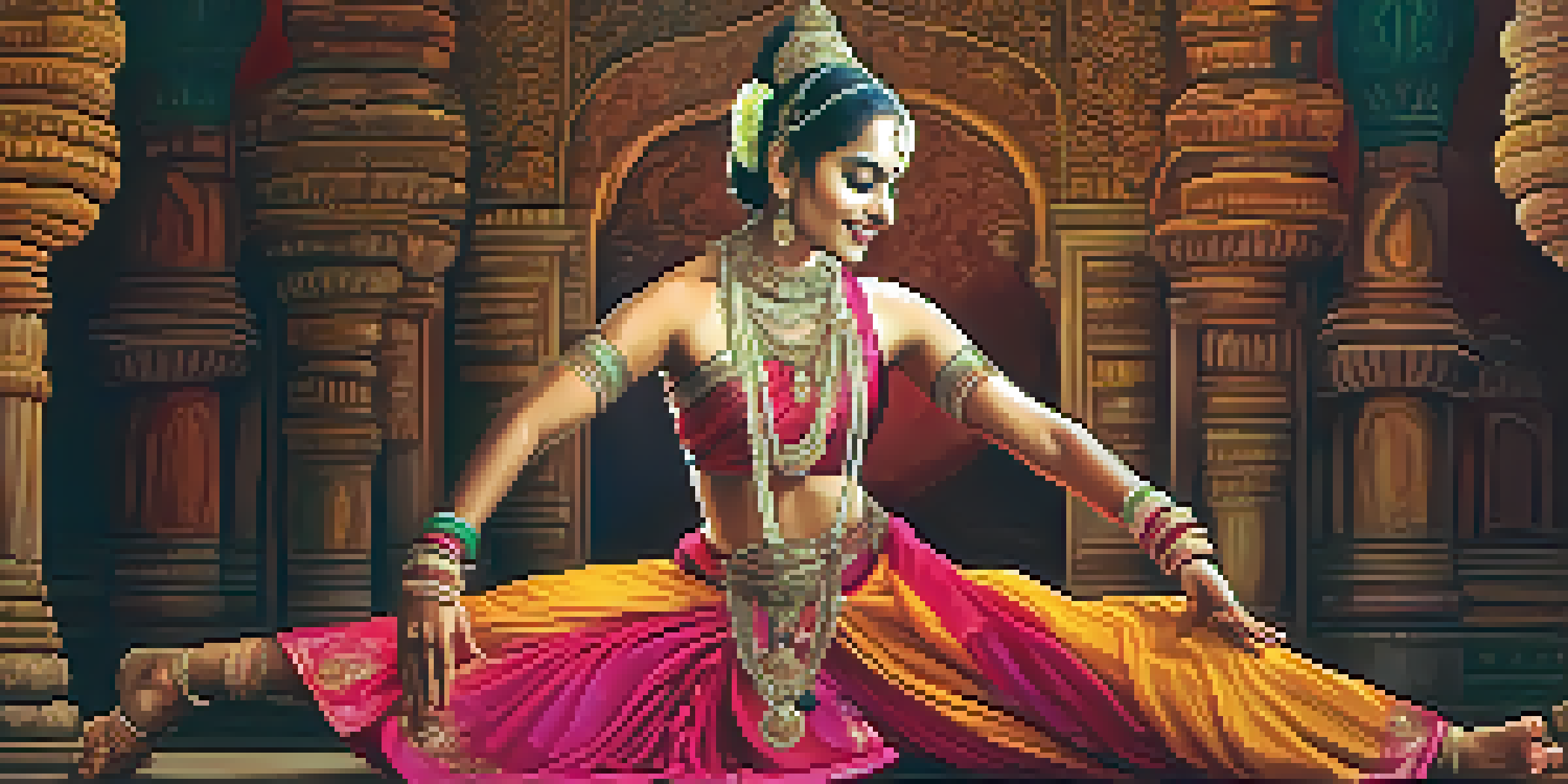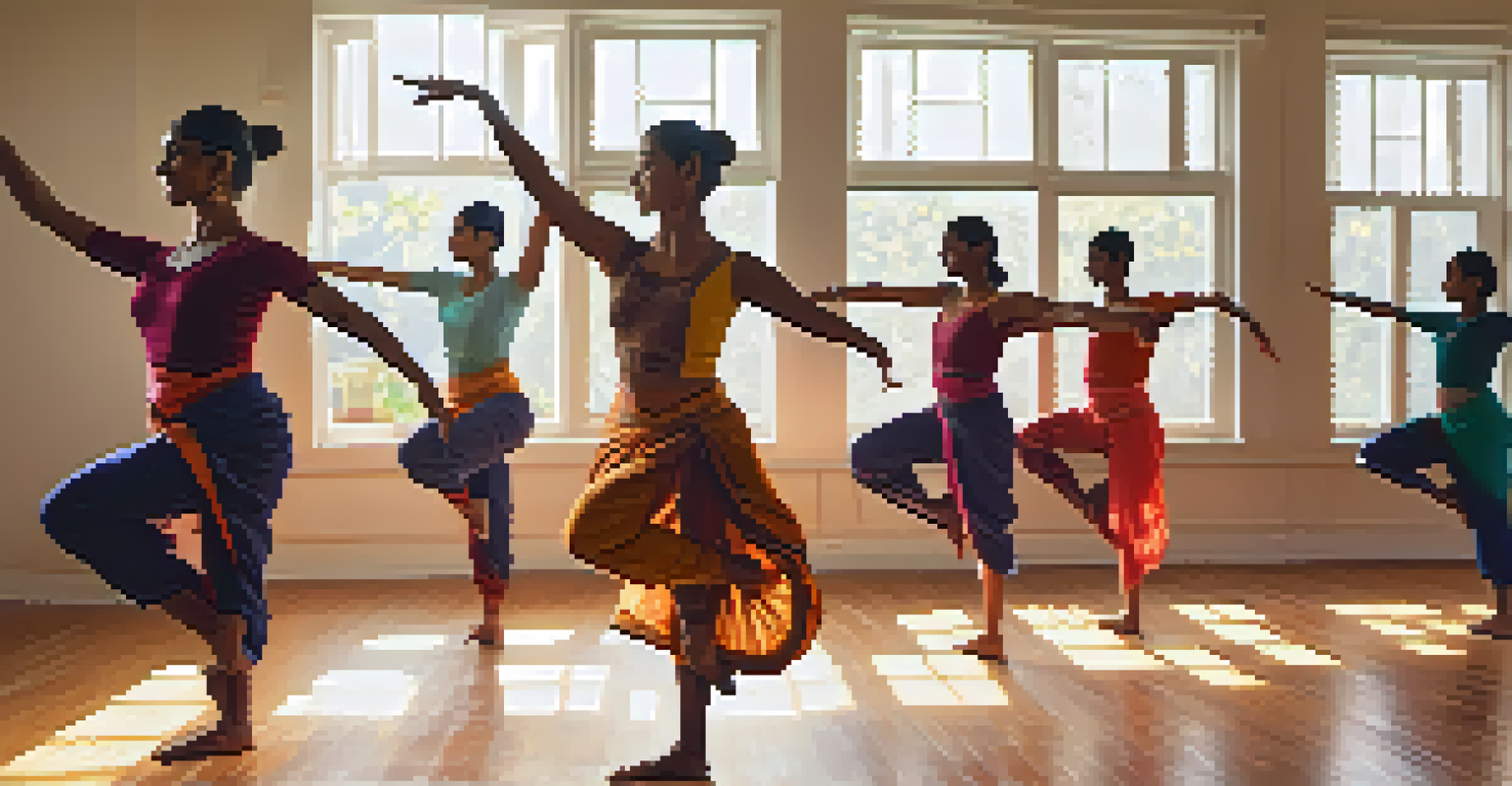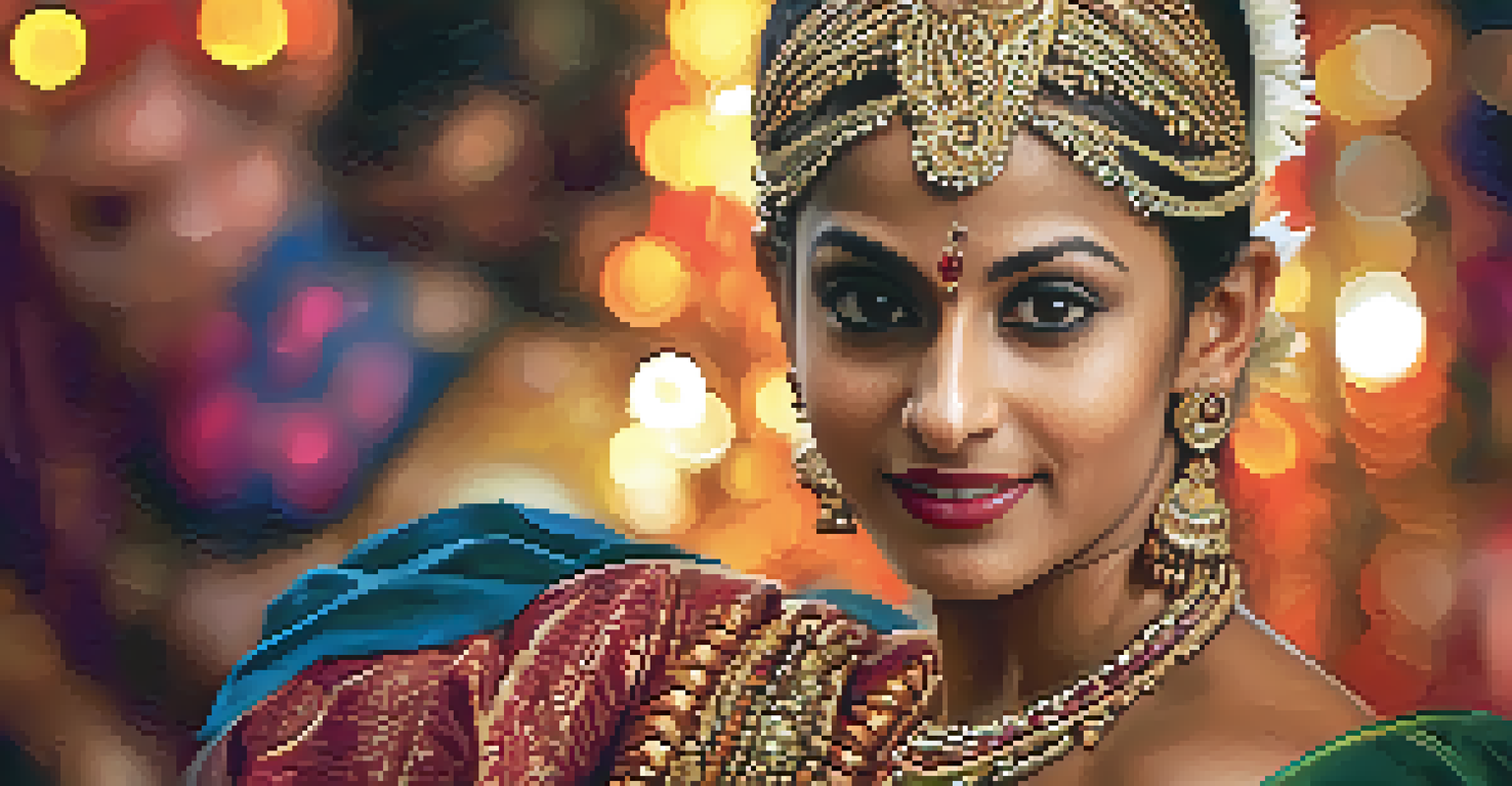Bharatanatyam: Dance and Its Healing Power in Indian Culture

Understanding Bharatanatyam: More Than Just a Dance
Bharatanatyam is one of the oldest classical dance forms originating from Tamil Nadu, India. It combines intricate footwork, expressive hand gestures, and vibrant costumes to tell stories from Hindu mythology. More than mere entertainment, this dance form serves as a spiritual practice for many dancers, connecting them to their cultural heritage.
Dance is the hidden language of the soul.
Historically, Bharatanatyam was performed by Devadasis, women dedicated to temple service, using dance as a form of devotion. Today, it has evolved into a celebrated art, showcasing the beauty of Indian culture on global stages. Each movement has a purpose, conveying emotions and narratives that resonate with audiences, transcending language barriers.
Through its rich history and expressive nature, Bharatanatyam stands as a testament to the resilience and creativity of Indian culture. It invites both performers and viewers to engage in a dialogue that goes beyond words, fostering a deeper understanding of community and identity.
The Healing Aspects of Bharatanatyam in Traditional Practices
In Indian culture, dance has long been regarded as a therapeutic practice, with Bharatanatyam at the forefront. The rhythmic movements and intricate choreography not only promote physical fitness but also enhance mental well-being. Practitioners often find solace in the dance, using it as a tool for stress relief and emotional expression.

The practice of Bharatanatyam involves deep breathing and mindfulness, akin to forms of meditation. This holistic approach helps dancers connect with their inner selves, alleviating anxiety and fostering a sense of peace. As they immerse themselves in the art, many report feelings of joy and liberation, reinforcing the idea that dance can heal.
Bharatanatyam: A Healing Art
Bharatanatyam serves as a therapeutic practice, promoting physical fitness and emotional well-being through its rhythmic movements and storytelling.
Moreover, Bharatanatyam's emphasis on storytelling allows dancers to process their emotions and experiences creatively. This form of expression can be particularly beneficial in therapeutic settings, where movement becomes a language of healing, helping individuals articulate feelings that might otherwise remain unspoken.
Bharatanatyam and Emotional Expression: A Path to Healing
Emotional expression is central to Bharatanatyam, where each dance piece conveys a specific mood or story. Dancers use facial expressions, known as 'abhinaya', to connect with the audience on a deeper level. This ability to express complex emotions through movement can be incredibly cathartic for performers, often leading to personal healing.
Through dance, we can express what we cannot say with words.
For many dancers, portraying various characters and emotions allows them to explore their inner worlds. This exploration can lead to insights about their own lives, facilitating personal growth and healing. By embodying different roles, dancers can confront their feelings, fears, and joys, turning the stage into a safe space for self-discovery.
Furthermore, this emotional journey is shared with the audience, creating a powerful bond that enhances the overall experience. Witnessing the authenticity of a dancer's expression can evoke empathy and connection, reminding us of our shared humanity and the healing power of art.
Cultural Significance of Bharatanatyam in Community Healing
Bharatanatyam plays a pivotal role in community bonding and healing, especially in Indian festivals and celebrations. These events bring people together, fostering a sense of belonging and collective joy. The shared experience of witnessing or participating in a performance can strengthen community ties, reminding individuals of their cultural roots.
During times of distress or tragedy, dance serves as a medium for collective healing. Communities often turn to Bharatanatyam performances to uplift spirits and foster resilience. The rhythmic movements and music can provide comfort, allowing individuals to process grief and find solace in shared expressions of artistry.
Cultural Connection Through Dance
The dance form fosters community bonding and healing, especially during festivals, by bringing people together and reinforcing cultural roots.
Moreover, Bharatanatyam workshops and classes often create spaces for dialogue and connection among participants. These gatherings not only teach the dance but also foster friendships and support networks, reinforcing the idea that togetherness is a powerful antidote to life's challenges.
Bharatanatyam as a Therapeutic Tool in Modern Times
In recent years, Bharatanatyam has been embraced as a therapeutic tool in various wellness practices. Dance therapy, which incorporates movements like those in Bharatanatyam, is gaining recognition for its ability to address physical, emotional, and psychological issues. This modern application reflects the timeless relevance of this ancient art form.
Dance therapy sessions often include Bharatanatyam techniques, allowing participants to engage with their bodies through structured movements. This can lead to improved body awareness, emotional release, and even pain relief. The combination of dance and therapy highlights the multifaceted benefits of Bharatanatyam, making it an invaluable resource in contemporary healing practices.
Furthermore, these therapeutic practices are helping to bridge traditional and modern approaches to health. By integrating Bharatanatyam into wellness programs, practitioners are not only preserving cultural heritage but also expanding the reach of its healing potential, making it accessible to diverse audiences.
Learning Bharatanatyam: A Journey of Self-Discovery
Embarking on the journey to learn Bharatanatyam is often seen as a transformative experience. The rigorous training involved requires discipline, commitment, and a willingness to explore oneself. As students navigate the complexities of the dance, they often uncover new layers of their identity, promoting personal growth and self-awareness.
Through the process of mastering the various techniques, dancers develop patience and resilience. Each performance is not just a display of skill but a reflection of their dedication and passion. This journey encourages individuals to confront challenges head-on, fostering a sense of accomplishment that extends beyond the dance floor.
Balancing Tradition and Innovation
The future of Bharatanatyam lies in blending its rich traditions with innovative expressions to engage new audiences while preserving its heritage.
Moreover, the community aspect of learning Bharatanatyam fosters supportive relationships among students and teachers. These connections create an environment where individuals feel safe to express themselves, share experiences, and grow together, reinforcing the idea that the journey itself is as valuable as the destination.
The Future of Bharatanatyam: Preserving Tradition and Innovation
As Bharatanatyam continues to evolve, there lies an opportunity to blend tradition with innovation. Contemporary dancers are exploring new themes and styles while respecting the core elements of this classical form. This fusion not only keeps the art relevant but also attracts a younger audience, ensuring its survival for future generations.
Innovation in Bharatanatyam can also extend to its presentation, with performances incorporating modern technology and multimedia. This approach can enhance storytelling, making it more relatable to today’s audience while maintaining the dance's rich heritage. Such adaptations highlight the versatility and adaptability of Bharatanatyam in a rapidly changing world.

Ultimately, the future of Bharatanatyam depends on a delicate balance between honoring its roots and embracing new expressions. As long as dancers continue to explore and share their passion for this art form, Bharatanatyam will remain a vibrant source of healing, connection, and cultural pride.